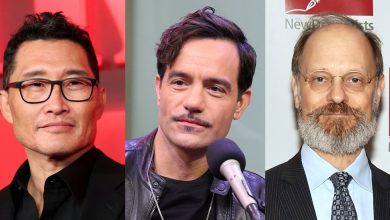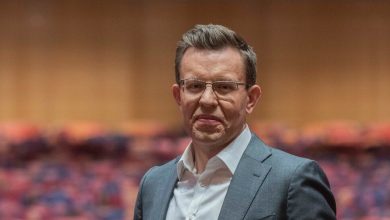The Bolero Is Timeless. Miguel Zenón Is Giving It a Jazzy Tinge.

On New Year’s Eve 2020, the saxophonist Miguel Zenón and his longtime collaborator, the pianist Luis Perdomo, took the stage at the Jazz Gallery in Manhattan to perform a makeshift duet concert that would be recorded for a live album. The set list included a collection of classic Latin American boleros they were fond of, reimagined through a jazz lens, much as giants like John Coltrane and Miles Davis did with the American songbook in the mid-20th century.
“It was a live show, but there wasn’t anyone there,” Zenón, 45, said on a recent video chat, describing one of the biggest challenges for musicians during coronavirus shutdowns. “It’s weird because playing this music live has a lot to do with the energy you get from the room.”
Feelings of loss and nostalgia permeate the bolero, a kind of ballad that incorporates romantic European lyricism with Afro-Cuban percussive elements. Boleros originated in Eastern Cuba and eventually spread to Mexico and the rest of Latin America, becoming standard material for an array of star vocalists. Onstage, Zenón and Perdomo rearranged classics made famous by Beny Moré, La Lupe and Sylvia Rexach, bringing out their universal musical language of passion and rhythm.
“In a world where everything is so complex, boleros kind of bring you back to things that make you feel good and help you process things like love and heartbreak,” said Adrian Quesada, the Black Pumas guitarist and singer-songwriter and a fan of boleros.
Zenón and Perdomo’s album, “El Arte del Bolero,” broke through to pandemic-weary listeners as an astonishingly intimate and stirring performance and picked up Grammy and Latin Grammy nominations. And now, a year after the LP’s release, Zenón is finally back before live audiences; he’ll perform with his quartet at Columbia’s Miller Theater on Friday.
Zenón, a MacArthur “genius” grant recipient in 2008, has long had a tendency to shift between his grounding in traditional jazz and his roots in San Juan, Puerto Rico, the home of salsa, reggaeton, and still, bolero. After attending his hometown’s Escuela Libre de Música — his classmates included the reggaeton superstar Daddy Yankee, who was there to play trombone — Sánchez arrived at Berklee School of Music in Boston with visions of bebop dancing in his head.
“My main thing was I just wanted to play like Charlie Parker and Coltrane and Cannonball,” Zenón said of Julian Adderley. “But I quickly came to understand that I really didn’t know my music, the music of Puerto Rico.If I wanted to play something slow, instead of playing standards from the Great American Songbook, I’d rather go into my world, you know?”
Zenón began to think of his rediscovery of his Puerto Rican and Latin American roots — a task of nostalgia-inducing methodological research — as a bridge to reconnect him to the island, like the longing for a lost homeland that fueled the Puerto Rican bandleader Rafael Hernández to write his famous bolero, “Silencio,” while he was living in New York in 1932. Zenón covered “Silencio,” revived in 2000 by Cuba’s Buena Vista Social Club, for his 2011 release “Alma Adentro: The Puerto Rican Songbook.”
Perdomo, 51, is in many ways Zenón’s perfect musical partner. He grew up in Caracas, Venezuela, listening to pianists like Oscar Peterson at first, then going through a salsa phase that had him emulating Eddie Palmieri and the Sonora Ponceña’s Papo Lucca. Perdomo decided to come to New York in the 1990s, and while he was studying at Manhattan School of Music with another Zenón collaborator, the bassist Hans Glawischnig, he met Zenón and quickly realized how talented he was.
“I thought: This guy is amazing! Rhythmically, he was perfect,” Perdomo said in an interview. With Glawischnig and the drummer Adam Cruz, they formed a quartet that played regularly at the old East Village club C Note, not far from Slug’s Saloon and the Five Spot, where Lee Morgan and Eric Dolphy once held sway in the 1960s.
For the New Year’s Eve concert, Zenón and Perdomo reworked their performance of Beny Moré’s classic “Cómo Fue,” which had become a signature live tune, playing it in D flat rather than E flat “because I was listening to a lot of Duke Ellington and Billy Strayhorn at the time,” Zenón said. They performed “Este Hastío” (“This Weariness”), a song written by the Cuban pianist Meme Solís for the jazz-inspired singer Elena Burke, then covered as “Piensa en Mi” (“Think of Me”) on Ray Barretto’s 1979 salsa masterpiece “Ricanstruction.” They treated “La Vida es Un Sueño” (“Life Is a Dream”), perhaps the Cuban orchestra leader Arsenio Rodríguez’s most famous song, with a kind of poignant reverence, drawing from a previous cover by the Cuban jazz-fusion groupIrakere.
One of the most affecting songs on the album is “Qué te Pedí” (“What Did I Ask of You”), made famous by the Cuban singer La Lupe, who spent much of her life in New York. Beginning with a long, swirling Zenón solo, the song evokes the bitter sadness of a failed relationship as longingly as Billie Holiday’s “Good Morning Heartache.”
“We played this with La Lupe in mind,” Zenón recalled. “It’s a kind of gritty, greasy version of bolero,” he said, and it seems more emotional, sadder, like the blues.
Perdomo, whose brief excursion into the Cuban guajira style closes “Que te Pedi,” said he has been struck by the intersections he discovers when playing Latin American boleros through a jazz lens. “Everything comes from African music, but there are some elements that go between different roots. It’s like how flamenco singers sing — it sounds like when B.B. King sings the blues.”
Although bolero was created in Cuba — drawing from rhythms that migrated from Haiti following its revolution — it has deep resonance in Mexico and much of South America. Maybe it’s about processing the sadness of migration, or an unspoken story about the wounds of colonization. My uncle’s brother, Fernando Álvarez, was the founder of one of Puerto Rico’s most famous trio-bolero groups, Trio Vegabajeño, which like Cuba’s Trio Matamoros and Mexico’s Trio Los Panchos used three harmonizing singers to popularize the genre in Puerto Rico, making the first recorded version of “En mi Viejo San Juan” in 1943.
Some Latinos grew up with scratchy-record boleros from their elders, or retooled salsa versions, while others remember the emotive excesses of singers like Juan Gabriel and José José. Those vocalists’ over-the-top emotion, a style some call “corta-venas” (literally cut your veins) may be linked to young Latin Americans’ ongoing attraction to emo music (and Mexican youth’s particular obsession with the woe-is-me rock balladry of Morrissey).
Re-engaging the deep feelings invested in boleros can have the effect of transforming sad memories into a kind of newfound hope and passion. And the genre continues to appeal to new generations. In June, Quesada of Black Pumas is releasing “Boleros Psicodélicos,”a mix of covers and original songs that try to capture the moment in the 1960s and 1970s when young Latin American musicians fused the bolero with psychedelic guitars and atmospheric electric organs.
“I was driving with my father, and I heard a song called ‘Esclavo y Amo’ by a group called Los Paseteles Verdes and became obsessed,” Quesada, 45, said from his home in Austin. Working with the Puerto Rican singer ILe, who turned him on to the Argentine idol Sandro, the eclectic indie singer Gabriel Garzón Montano, the guitarist Marc Ribot and others, Quesada seems to have tapped into an emerging mood in Latin music.
This year has also seen the release of an album of satirical boleros by Puerto Rico’s Los Rivera Destino, who became YouTube stars by landing Bad Bunny on their original bolero “Flor.”
Zenón remembered growing up listening to the Sunday morning bolero shows on San Juan radio and his mother’s obsession with Sylvia Rexach, whose “Alma Adentro” is a centerpiece of “El Arte del Bolero.”
“Even though it was from before our time,” he said, “it’s still here, in our time.”
Miguel Zenón will be playing with Luis Perdomo on piano, Hans Glawischnig on bass and Henry Cole on drums at Columbia’s Miller Theater on Friday; millertheatre.com.





